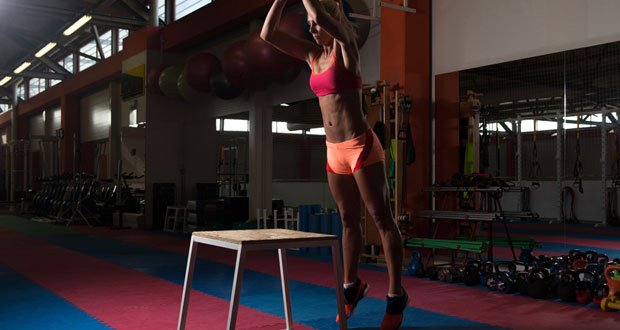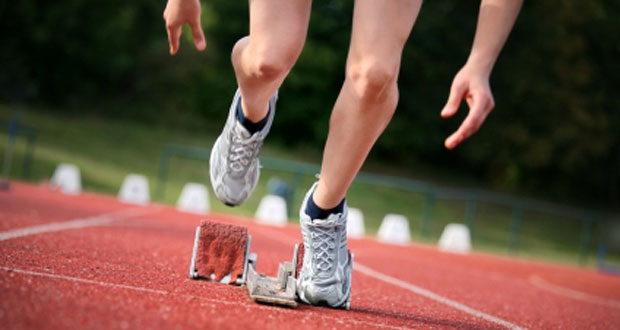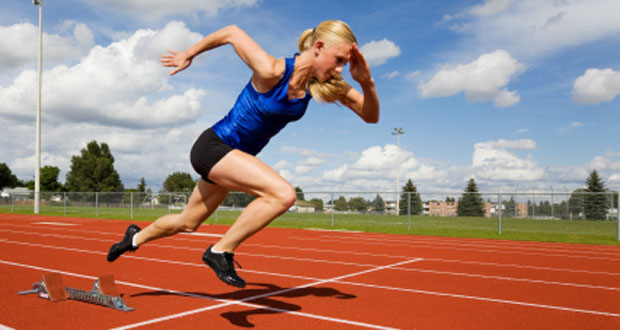Plyometric training involves quick, powerful, jumping and bounding movements. Their purpose is to increase muscular power and dynamic strength and big gains can be made but equally, care must be taken this type of training can have a high risk of injury.
Because of the high proportion of eccentric muscle contraction when performing plyometric exercise, injury is a real concern. For this reason, plyometrics should only be performed by athletes with a good training background and under the supervision of a coach or trainer experienced in this kind of training.
Examples of plyometric training drills include:
- Standing jumps – including standing jumps or jumping over barriers such as hurdles, steps or boxes
- Multiple hops and jumps – usually a combination of repeated jumps
- Bounds – these are exaggerated drills with a focus on horizontal movement usually over a distance of at least 30 meters
- Box drills – involve a raised box or step which is jumped onto or off of. These are more intense forms of plyometrics
- Depth jumps – the most intense form of plyometrics.
The athlete steps off a box, lands and immediately jumps forwards,
upwards, or sometimes up onto another box.
Upper body plyometrics are possible, although are less varied and less widely used than lower-body plyometrics. They often involve throwing and catching a medicine ball or performing push-up variations. Athletes involved in throwing sports most commonly use this type of training.
Physiology
The way in which plyometric exercises increase muscular power utilises the natural elasticity of the muscle and tendon, as well as the stretch reflex. When we jump, in the landing phase our quads must contract eccentrically (lengthening, to resist gravity), to slow the movement. This increases the elastic energy in the muscle and tendon as the muscle lengthens. This energy is then stored in the muscle. Following the eccentric, landing phase, with an immediate concentric contraction (such as jumping up again), causes the stored energy to be released. This increases the total force produced.
The stretch reflex is the body’s response to a muscular stretch. This response, which is involuntary, is initiated by the muscle spindles (stretch receptor organs within a muscle). The muscle spindles detect the speed and intensity of a stretch and so during plyometrics, detect the rapid stretching of the quads (when landing). Their response is to protect the muscle from over-stretching by increasing the activity of the quads (the agonist muscles) and so the force the muscles produce.
Plyometric activities can be broken down into three parts:
- The eccentric phase, or landing phase, where the agonist muscles are contracting eccentrically to control movement
- The amortisation phase, or transition phase, which is the time between eccentric and concentric contractions
- The concentric phase, which is the jumping phase, when the agonist muscles contract concentrically
The amortisation phase, the time between the eccentric and concentric contractions, must not be too long. as the energy from the contractile parts of the muscle which is produced during the first eccentric phase, dissipates very quickly. Therefore, the subsequent concentric contraction must occur as soon after the eccentric phase as possible, to get the most benefit from the exercise.
Training Programs
The most important aspect of a plyometric training program is the warm-up. Without a thorough warm-up, the athlete is placed at an increased risk of injury. A warm-up should include:
- A pulse-raising activity such as jogging, skipping, cycling, etc. The aim of this is to increase the body temperature, circulation and warm the muscles
- Static stretches can be used after the pulse raiser to loosen specific areas
- Dynamic (or active) stretching drills, specific to the training session, should then be undertaken.
Plyometrics is a form of resistance training, and so plyometric training must conform to the usual principles of training, including frequency, overload, and recovery especially.
The frequency of a training program will vary considerably from athlete to athlete, sport to sport and point of the training cycle. At most, athletes could be expected to perform 3-4 plyometric sessions per week. It is recommended that a period of 48 hours is allowed for rest in between sessions.
As with all resistance training programs, in order to progress, you must overload the body. In a plyometric session, ways in which the intensity can be increased to achieve this overload, include:
- Increased speed of performance
- Higher box jumps, depth jumps and bounds
- Performing single leg drills
- Increasing the distance covered in bounding drills
- Adding weights to the athlete (weight vests/ankle weights etc) to increase their body weight
Recovery is the period between reps and sets in one training session. Because plyometrics focus on improving anaerobic power, using maximal efforts, adequate recovery is required between drills. A typical example would be 10 seconds between reps and 3 minutes between sets.
Safety
Plyometrics is a perfectly safe form of training, provided that a number of factors are taken into consideration:
Warm-up
As described above, a warm-up should be thorough to ensure that the muscles are warm and ready to perform at such a high level. As well as a warm-up, the session should progress with easier drills first, leading to more demanding jumps.
Technique
Technique should always be demonstrated and explained to the athlete before they attempt a jump. Landing technique is of particular importance
Pre-training
The athlete must have a good base level of fitness, especially strength, balance, speed, and coordination before they begin a plyometric training program. A guideline for lower body strength is that the athletes 1 rep max squat weight should be 1.5 times their body weight. Balance should be tested using a single leg stance test where balance must be maintained for a minimum of 30 seconds to qualify for initiating a basic plyometric program.
Athlete characteristics
Athletes who are heavier than around 220 lbs (100 Kgs/15st 7lb) should not take part in the more high-intensity aspects (e.g. depth jumps) of plyometric training due to the excess weight placing extreme pressure on their joints when landing. Also, athletes suffering from recent or unresolved injuries should not take part.
Equipment
The area and equipment used for plyometric training must be considered. The floor surface should provide a good degree of shock-absorbing, such as grass or rubber matting. Concrete or tiles are not suitable. Space must also be considered in terms of floor space, but also ceiling height. Where depth jumps are being performed, a height of 3-4 meters is necessary.
The participants should also be wearing suitable footwear. A good shoe would provide ankle and arch support, lateral stability and a wide, non-slip sole. They should also be well cushioned to help reduce shock and to this end, not be worn-out!
Equipment used in plyometrics usually involves boxes, which should be sturdy and have a non-slip top surface. The top surface should also be at least 18 inches (45cm) wide and box height should vary between 6 and 42 inches (15-107 cm).




